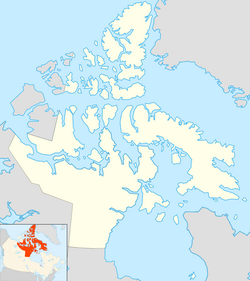スミス海峡
| スミス海峡 | |
|---|---|
 | |
| 座標 | 北緯78度25分 西経74度00分 / 北緯78.417度 西経74.000度座標: 北緯78度25分 西経74度00分 / 北緯78.417度 西経74.000度 |
| 海洋 | ケイン湾(en) / バフィン湾 |
| 国 | カナダ、グリーンランド |
| 延長 | 50 km (31 mi) |
| 最大幅 | 40 km (25 mi)[1] |
| 凍結 | 一年の大部分 |
| 島 | ピム島(en: Pim Island)、リトルトン島( en) |
| 主な沿岸自治体 | 非居住地 |
スミス海峡(スミスかいきょう)は、グリーンランドとカナダのエルズミーア島との間のネアズ海峡の一部であり、バフィン湾南部[2]と同じくネアズ海峡の一部である ケイン湾(en)とを結ぶ。
この海峡のグリーンランド側の沿岸には、現在は廃村となっているエタ、アンノアトックの定住地があった[3]。
歴史[編集]
判明している限りでは、スミス海峡にヨーロッパ人が初めて訪れたのは1616年のディスカヴァリー(船長:ロバート・バイロット(en)操縦士:ウィリアム・バフィン)であった。 イングランド人の外交官トーマス・スマイス(en)のあとに独自に「トーマス・スミスの海峡」と命名され、1750年代には地図上に正式に掲載されるよえになった。1818年の ジョン・ロスによるものまで、この海域でこれより北に到達した探検はなかった。その頃には、トーマス・スミスの海峡は単に「スミス海峡」と呼ばれるようになった。
1852年には、エドワード・オーガスタス・イングルフィールド(en)がバフィン湾のわずかに北を通り、知られている新たな北アメリカ最北の地となった。
脚注[編集]
- ^ Google Earth
- ^ 国際水路機関の定義ではスミス海峡も含むネアズ海峡もバフィン湾に含まれる。
- ^ Gretel Ehrlich, Gretel (2001). This Cold Heaven: Seven Seasons in Greenland. Random House. pp. 26–7,141,239,348. ISBN 978-0-679-75852-5
参考文献[編集]
- Blake, W. 1999. "Glaciated Landscapes Along Smith Sound, Ellesmere Island, Canada and Greenland". Annals of Glaciology. 28: 40-46.
- Elton, Charles S. Movements of Arctic Fox Populations in the Region of Baffin Bay and Smith Sound. The Polar Record. [Offprint], no. 37-38. [Cambridge: University Press], 1949.
- Grist, Alexander, and Marcos Zentilli. 2005. "The Thermal History of the Nares Strait, Kane Basin, and Smith Sound Region in Canada and Greenland: Constraints from Apatite Fission-Track and (U Th Sm)/He Dating". Canadian Journal of Earth Sciences. 42: 1547-1569.
- Kroeber, A. L. The Eskimo of Smith Sound. [New York: Knickerbocker Press], 1900.
- Peary, Robert E. Northward Over the "Great Ice" A Narrative of Life and Work Along the Shores and Upon the Interior Ice-Cap of Northern Greenland in the Years 1886 and 1891-1897 : with a Description of the Little Tribe of Smith-Sound Eskimos, the Most Northerly Human Beings in the World, and an Account of the Discovery and Bringing Home of the "Saviksue," or Great Cape-York Meteorites. London: Methuen, 1898.


